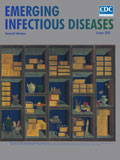
Volume 26, Number 10—October 2020
Synopsis
Operating Protocols of a Community Treatment Center for Isolation of Patients with Coronavirus Disease, South Korea
Article Metrics
Abstract
Most persons with confirmed coronavirus disease (COVID-19) have no or mild symptoms. During the COVID-19 pandemic, communities need efficient methods to monitor asymptomatic patients to reduce transmission. We describe the structure and operating protocols of a community treatment center (CTC) run by Seoul National University Hospital (SNUH) in South Korea. SNUH converted an existing facility into a CTC to isolate patients who had confirmed COVID-19 but mild or no symptoms. Patients reported self-measured vital signs and symptoms twice a day by using a smartphone application. Medical staff in a remote monitoring center at SNUH reviewed patient vital signs and provided video consultation to patients twice daily. The CTC required few medical staff to perform medical tests, monitor patients, and respond to emergencies. During March 5–26, 2020, we admitted and treated 113 patients at this center. CTCs could be an alternative to hospital admission for isolating patients and preventing community transmission.
Since the first suspected case was reported in December 2019 (1,2), the number of coronavirus disease (COVID-19) cases has risen steeply worldwide (3,4). In South Korea, COVID-19 outbreaks occurred at religious facilities and the number of cases increased drastically, especially in Daegu City and the North Gyeongsang Province, and the number of patients with asymptomatic or mild symptoms increased exponentially (5,6). In the early stages of the COVID-19 epidemic, all patients with diagnosed COVID-19 were hospitalized in negative-pressure isolation units to treat the disease and prevent the spread of infection. However, because the infection spread rapidly, the number of patients exceeded the number of available negative-pressure isolation beds. Because of limited medical resources and the COVID-19 epidemic curve, concerns grew that new facilities would be needed to isolate and care for patients in South Korea.
The National Health Insurance System (NHIS) of South Korea offers complete access to healthcare for the entire population (13). South Korea’s medical utilization rate is the highest, 16.6 outpatient visits per capita per year, among Organization for Economic Cooperation and Development (OECD) countries (14). Citizens of South Korea have high access to medical services. Before the COVID-19 pandemic, no one in the country anticipated a situation in which hospital admission would be denied. South Korea has 2.6 times more hospital beds than other OECD countries, 12.3/1,000 population. However, the country only has 1,027 negative-pressure isolation beds, and these are not distributed across all regions. When the COVID-19 pandemic reached South Korea, the number of available negative-pressure isolation beds decreased, and patients could not be admitted to the hospital because of the shortage of medical facilities, especially in regions where outbreaks mainly occurred.
When an imbalance between the demand and supply of medical resources exists, adequate triage of patients is critical for allocating limited resources to patients who can benefit the most (7). In a large-scale study from China, Wu et al. (8) suggested that ≈80% of COVID-19 symptomatic patients were reported to have mild upper respiratory infection without hypoxia, and only 20% of infected patients needed medical services. Until March 25, 2020, the crude mortality rate in South Korea was 1.4%, and estimates suggested the severity of COVID-19 in the country would not be high (9). However, considering asymptomatic carrier transmission (10), the high reproductive number (R0 = 2.2) (11), and the possibility of sudden deterioration (12), even patients with mild or no symptoms should be isolated and monitored.
On March 2, 2020, the government of South Korea started operating community treatment centers (CTCs) to provide quarantine, regular examination, and monitoring for asymptomatic and mildly symptomatic patients with laboratory-confirmed COVID-19. By March 25, a total of 17 CTCs were serving patients with mild symptoms nationwide. The CTC is designed to monitor and isolate patients with mild conditions during emerging infectious disease outbreaks. We describe the structure and operating protocols of a CTC operated by Seoul National University Hospital (SNUH) during the COVID-19 pandemic.






















.png)











No hay comentarios:
Publicar un comentario